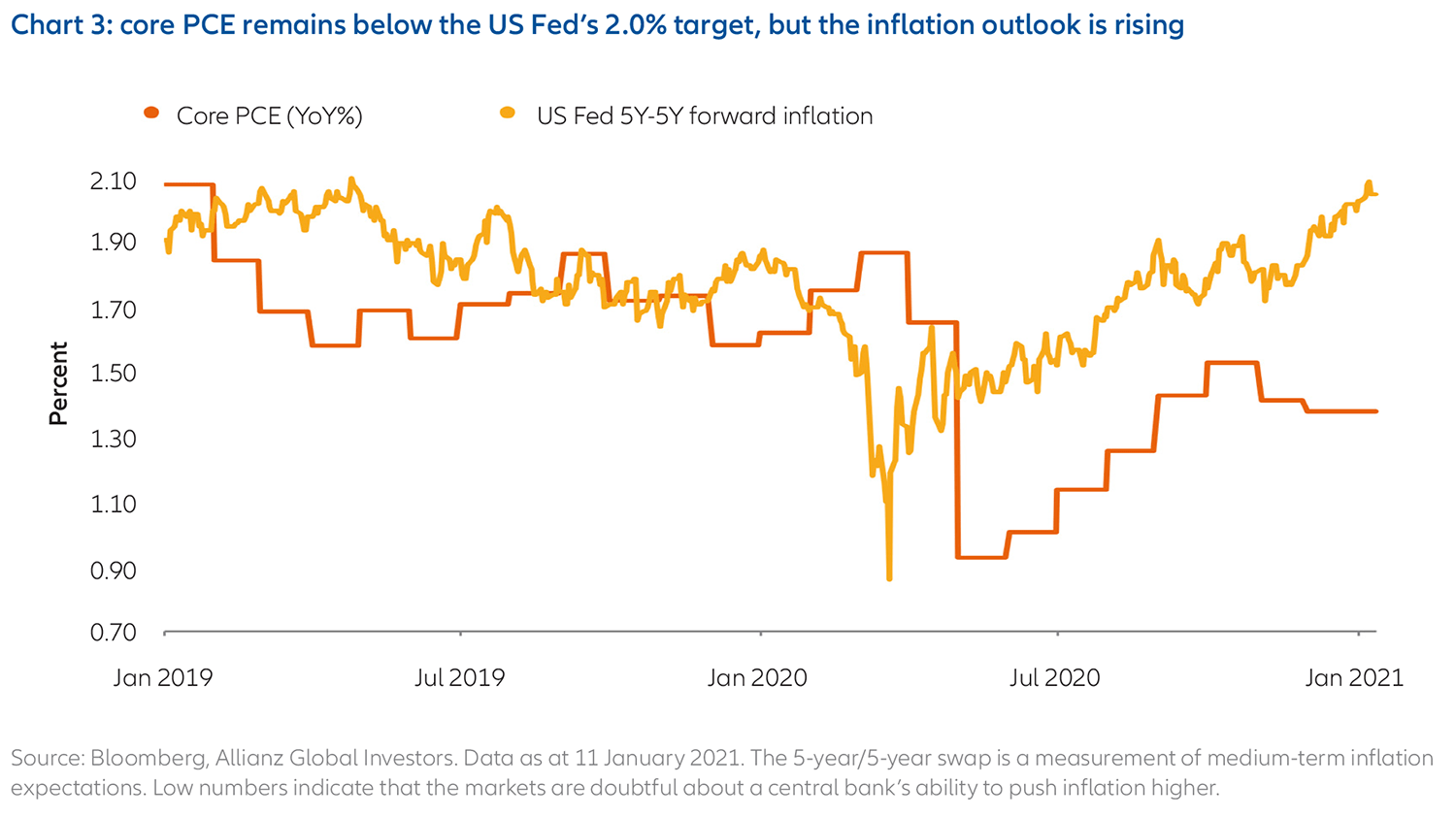Expect US market momentum to continue – but watch for inflation

Summary
Investors can start the year with a positive outlook for the markets thanks to three drivers: higher spending from the new Biden administration, wider uptake of vaccines and continued Fed support. Consider layering in exposure to value and cyclical stocks, small cap and international assets – but keep an eye on rising inflation.
Key takeaways
|
US markets have largely shrugged off the political volatility of the new year, continuing the momentum with which they ended 2020. Looking at different market sectors, value stocks continue to largely outperform growth stocks, and small caps are playing catch-up to large caps. At the same time, international and emerging-market equities are outpacing their US counterparts, driven by ongoing US dollar weakness, the prospects for stronger global growth and generally better valuations.
The financial markets are also counting on additional fiscal and monetary stimulus in 2021, as indicated by the Biden administration and the US Federal Reserve (US Fed), even as economic growth has already started to rebound. Against this backdrop, investors can start the new year with a positive outlook for the markets. Investors may want to tactically add to or diversify risk in portfolios, but it will be important to be vigilant as the year progresses – including watching for higher inflation down the road.
Three factors driving renewed momentum in the market shift towards value stocks
While keeping this positive outlook in mind, watch for inflationary pressures
While the economic and market outlook for 2021 is solid, there are some accompanying risks. One is that rebounding growth and stimulus could push up the prices of goods and services – driving up inflationary pressures. So far, inflation has been relatively contained, with core PCE – personal consumption expenditures, the US Fed’s preferred indicator – still below the US Fed’s 2.0% target. However, some forward-looking indicators (which measure the market’s inflation expectations) call for higher inflation, as Chart 3 shows.

If inflation does accelerate, we see three key risks for investors:
- The US Fed is now targeting an average inflation rate regime – meaning it will tolerate a period of higher-than-2.0% inflation without raising rates. But a sustained or rapid rise in inflation may cause the US Fed to rethink its approach. Historically, bear markets have begun when US Fed rate-hike cycles are on the horizon.
- If higher inflation leads to higher yields, longer-duration assets could suffer. These include certain government and corporate bonds, but also some sectors like technology and healthcare, which tend to be longer duration and could be punished by markets that fear higher inflation.
- Given that some stock valuations may already be stretched, particularly in certain growth areas, higher inflation and higher yields could push down these valuations over time.
Consider tactical shifts towards cyclicals and emerging markets
The global economy is recovering – in part thanks to “reflation” policies, such as fiscal stimulus and low rates, designed to boost demand and spending – and we expect it to enter a true reopening period later this year.
As such, we expect markets will continue to favour the reflation theme – but for how long? Perhaps until the economy either reaches peak reopening growth rates or enters a sustained period of inflation, which makes slowing growth or mounting inflationary pressures key indicators to watch.
Given such strong upwards movement already, periods of consolidation or market pullbacks should be expected in the weeks ahead. But investors can largely use these as tactical opportunities to add to or diversify risk. Consider adding incremental exposure by “layering in” cyclical and value stocks, small-cap stocks and non-US assets. Select areas of infrastructure, 5G technology and clean energy may also continue to do well in a post-election world.
In fixed income, prepare for somewhat higher rates and steeper yield curves. Long rates (which are generally determined by market forces) may rise alongside growth and inflation expectations, while short rates remain anchored by central banks. More stimulus could also mean a marginally weaker US dollar, which would continue to benefit emerging-market assets, gold and those industrial commodities (including copper) that are tied to the reopening.
“Year of the Ox” symbolises China’s strong future

Summary
This lunar new year, China has much to celebrate – including resilient economic growth, widespread success at suppressing Covid-19 and a steady transformation into an advanced economy. That’s why the ox is a suitable symbol for a country that continues to do the hard work needed to maintain its trajectory.
Key takeaways
|






The Democrats’ “blue sweep” became reality
Following the US election results in November, it appeared likely that incoming President Joe Biden would face a “divided” US Congress and gridlock in the US government, putting most of his agenda in peril. But the resolution of Georgia’s Senate races ultimately ceded control of both the House and Senate to the Democrats, although they still have only slim majorities. That makes a “Biden-lite” agenda likely: for example, tax increases will be less than initially outlined and may not be a year-one priority. Instead, we expect the new administration to first pursue policy items that have more bipartisan support from both Democrats and Republicans, such as stimulus packages and fiscal spending:
Vaccines are finally here, despite the slow rollout
Stimulus is certainly a helpful bridge for consumers and small businesses, but as long as the pandemic is ongoing, economic activity is likely to remain depressed. Fortunately, vaccine distribution has begun in the US and globally. If it’s effective, the subsequent economic reopening will likely be the biggest market driver in the US and globally in 2021.
In such a scenario, we expect pent-up consumer demand to be unleashed – particularly in sectors such as travel and leisure that would benefit from the reopening economy. This is already reflected in strong economic and earnings forecasts, as Chart 1 shows, although they could move higher in future earnings revisions if more progress is made fighting the pandemic.
So far, however, the US rollout of the vaccines has been slower than anticipated. But this may turn around based on a few factors: states will learn how to make distribution more effective; the Biden administration will focus on increasing the number of doses available; and new vaccines from other companies should reduce supply constraints.
Barring any severe shocks or setbacks – including new variants of the virus – 2021 is likely to be a year of reaccelerating economic growth. For investors, this may mean that a bear-market selloff, which often occurs ahead of recessions, appears unlikely in the near term. As a result, market corrections could largely be used as tactical buying opportunities.
The US Fed will continue to support markets in 2021
In its final meeting of 2020, the US Fed released an updated set of economic projections (see Chart 2). Through 2023, rates are expected to remain near zero and inflation below the US central bank’s 2.0% target. Growth and unemployment expectations were also upgraded, and the US Fed is committed to maintaining its monthly asset purchases. This will continue to expand the US Fed’s balance sheet and provide liquidity to markets.
Overall, central banks in the US and around the world continue to provide strong support for risk assets against what was already expected to be a recovery year.